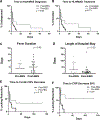An Evidence-Based Guideline Improves Outcomes for Patients With Hemophagocytic Lymphohistiocytosis and Macrophage Activation Syndrome
- PMID: 35840156
- PMCID: PMC9588491
- DOI: 10.3899/jrheum.211219
An Evidence-Based Guideline Improves Outcomes for Patients With Hemophagocytic Lymphohistiocytosis and Macrophage Activation Syndrome
Abstract
Objective: To compare clinical outcomes in children with hemophagocytic lymphohistiocytosis (HLH) and macrophage activation syndrome (MAS) who were managed before and after implementation of an evidence-based guideline (EBG).
Methods: A management algorithm for MAS-HLH was developed at our institution based on literature review, expert opinion, and consensus building across multiple pediatric subspecialties. An electronic medical record search retrospectively identified hospitalized patients with MAS-HLH in the pre-EBG (October 15, 2015, to December 4, 2017) and post-EBG (January 1, 2018, to January 21, 2020) time periods. Predetermined outcome metrics were evaluated in the 2 cohorts.
Results: After the EBG launch, 57 children were identified by house staff as potential patients with MAS-HLH, and rheumatology was consulted for management. Ultimately, 17 patients were diagnosed with MAS-HLH by the treating team. Of these, 59% met HLH 2004 criteria, and 94% met 2016 classification criteria for MAS complicating systemic juvenile idiopathic arthritis. There was a statistically significant reduction in mortality from 50% before implementation of the EBG to 6% in the post-EBG cohort (P = 0.02). There was a significant improvement in time to 50% reduction in C-reactive protein level in the post-EBG vs pre-EBG cohorts (log-rank P < 0.01). There were trends toward faster time to MAS-HLH diagnosis, faster initiation of immunosuppressive therapy, shorter length of hospital stay, and more rapid normalization of MAS-HLH-related biomarkers in the patients post-EBG.
Conclusion: While the observed improvements may be partially attributed to advances in treatment of MAS-HLH that have accumulated over time, this analysis also suggests that a multidisciplinary treatment pathway for MAS-HLH contributed meaningfully to favorable patient outcomes.
Keywords: hemophagocytic lymphohistiocytosis; macrophage activation syndrome.
Copyright © 2022 by the Journal of Rheumatology.
Conflict of interest statement
Figures



Comment in
-
Improving Outcomes for Patients With Hemophagocytic Lymphohistiocytosis.J Rheumatol. 2023 Jul;50(7):967. doi: 10.3899/jrheum.221010. Epub 2022 Nov 15. J Rheumatol. 2023. PMID: 36379564 No abstract available.
References
-
- Jordan MB, Hildeman D, Kappler J, Marrack P. An animal model of hemophagocytic lymphohistiocytosis (HLH): CD8+ T cells and interferon gamma are essential for the disorder. Blood 2004;104:735–43. - PubMed
-
- Prencipe G, Caiello I, Pascarella A, et al. Neutralization of IFN-gamma reverts clinical and laboratory features in a mouse model of macrophage activation syndrome. J Allergy Clin Immunol 2018;141:1439–49. - PubMed
Publication types
MeSH terms
Substances
Grants and funding
LinkOut - more resources
Full Text Sources
Research Materials
Miscellaneous
